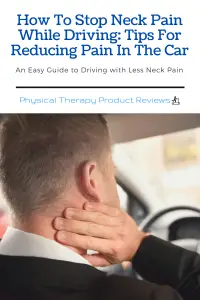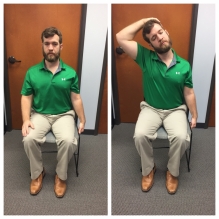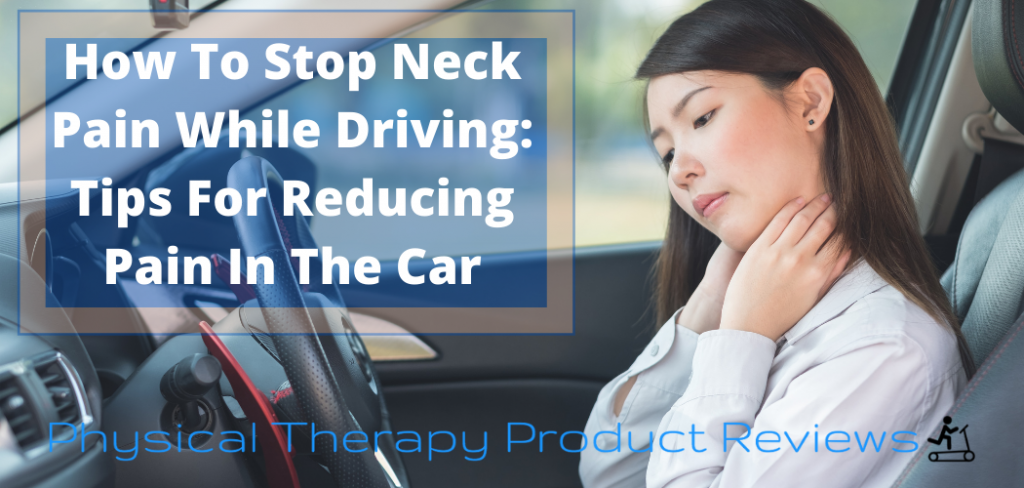Do you ever feel neck pain when driving? If so, you are not alone. Neck pain during driving is a common complaint and one of the main reasons people seek treatment for joint pain.
Neck pain while driving can be caused by many factors, including poor posture, lack of neck support, eye-straining, and improper hand positioning. There are some simple things that you can do to prevent neck pain while driving, which we will discuss in this article.
Neck Pain While Driving
If you have neck pain, then you certainly have noticed that it can be worse with driving. Driving can be difficult on the neck because you are in one position for a long time; you have to rotate the neck quickly to look for cars, and keep your arms up at shoulder height.
 If you have a previous neck injury, the unnatural driving position doesn’t take long to aggravate the neck. Most of the movement during driving has to come from the neck and upper back; there’s not much opportunity to compensate with other joints.
If you have a previous neck injury, the unnatural driving position doesn’t take long to aggravate the neck. Most of the movement during driving has to come from the neck and upper back; there’s not much opportunity to compensate with other joints.
Not only are there more movement demands for the neck while driving, but the chairs in most vehicles put you into an uncomfortable position. The car seats of today put you into a position that pushes the head forward and rounds the shoulder, which is a posture that we often try to avoid and break out of with physical therapy treatments.
Helpful Tips For Reducing Neck Pain with Driving
If you have neck pain, we’ve compiled our favorite ways that you can help modify and, in some cases, even get rid of neck pain while driving. These range from stretches and strengthening to posture aids and important education on the proper positioning of your neck and body.
Fix Your Neck Posture While Driving
One of the best ways to reduce neck pain while driving is to fix your neck posture. This means keeping a nice tall upright position throughout the drive and changing the position of your neck to more comfortable positions.
If you have poor neck posture or are slouching in general, driving will put even more stress on your neck and increase any pain you may feel. Make sure that when sitting in the car, you are sitting up tall with your neck in line with your spine.
The neck is also supposed to be directly over the shoulders and mid-back, not hunched forward or rounded into your upper back/shoulder blades. You can check your posture by constantly pushing your head back into the headrest. Your head shouldn’t have to move too far to be able to touch it.
Do Neck Stretches While Your Driving
Another way to help decrease neck pain while driving is by doing neck stretches. Our favorite stretch for the neck not only decreases neck pain but also can be done while you are driving or stopped at a stoplight.
Upper Trap Stretch
The neck stretch that we recommend is the upper trap stretch. This neck muscle tends to get really tight and can be one of the causes of neck pain while driving.
To do this neck stretch, sit up tall in your seat, take one hand over the head, and pull the head towards the shoulder on the same side as the pulling arm. Pull until there is a comfortable stretch and then return to normal. Hold 30 seconds at a time, and this is an easy stretch to do at stoplights or when stuck in traffic.

Repeat this stretch twice on each side, trying to do more repetitions or holding longer if you find less tension between repetitions.
Thoracic Extension Stretch
Another helpful stretch that you can do while driving is the thoracic extension stretch.
To perform this neck stretch, sit tall in your seat, take both hands behind your head, pull slightly backward with the hands, and bend the head backward. You should feel a nice chest opening sensation and a stretch across your upper back. Hold for 20-30 seconds.
Try Supporting Your Head When Driving
One of the simplest tips to decrease neck pain is to try and support your head when you are driving. You can use a neck support that attaches to the seat and keeps your head in proper alignment. This means keeping a tall neck, eyes looking forward (not down), and the chin pulled in slightly.
By trying to prevent yourself from constantly having to move your neck every time you look around your neck will be supported and kept in proper alignment which means less neck pain. You can let your muscles rest and still keep good posture.
Do Chin Retraction Exercises While Driving
Another neck pain tip while driving is to do a chin tuck or a chin retraction. The neck muscles actually attach from the base of your skull all the way down through our upper back and shoulder area which can be an epicenter for neck pain in general, not just when you are driving.
You can help stretch out your neck, upper back, and shoulder area by doing a chin tuck, decreasing neck pain. To do a chin tuck, sit up tall in your seat with a nice neck, pull the chin back towards the headrest, and hold for 5 seconds. This stretches out important muscles and strengthens other important neck muscles.
Do Chin Retraction Exercises While Driving
Another neck pain tip while driving is to do a chin tuck or a chin retraction. The neck muscles actually attach from the base of your skull all the way down through our upper back and shoulder area which can be an epicenter for neck pain in general, not just when you are driving.
You can help stretch out your neck, upper back, and shoulder area by doing a chin tuck, decreasing neck pain. To do a chin tuck, sit up tall in your seat with a nice neck, pull the chin back towards the headrest, and hold for 5 seconds. This stretches out important muscles and strengthens other important neck muscles.
Have Your Eyes Checked to Avoid Squinting and Headaches
Another neck pain tip is to have your eyes checked. If you are a driver that has been squinting, straining the neck muscle, and/or headaches, then it might be time for an eye checkup.
If you are constantly trying to look at a hard to read signs your head it automatically going to fall forward into the painful position. Even if you only wear glasses while driving, that can go a long way to helping prevent neck pain.
You don’t need to wear glasses but having your eyes looked at by a professional can help diagnose if there is an underlying issue that can cause neck pain while driving.
Adjust Your Mirrors to a Better Position While Driving
Another tip while driving is to get in the habit of adjusting your rearview and side mirrors. You can see directly behind you to help prevent neck strain and neck pain when looking for cars or other objects trying to pass. The less you have to look up or to the sides to see your blind spots, the less stress on the neck.
This simple adjustment will reduce neck pain really quickly and keeping an upright posture, supporting your head, checking your eyes, and get, adjusting your mirrors and neck sup can help decrease neck pain while driving.
Try a Different Hand Position While Driving
Try changing your hand position while driving. The higher you hold the steering wheel such as the “10 and 2” position the harder it is on your neck.
Instead, try holding the steering wheel at an “8 and 4” position and this will take pressure off the steering. Also, changing between the two positions is a great way to keep your neck and arms from getting stiff.
Conclusion
The intent of this article is to review tips for decreasing neck pain while driving. This includes keeping an upright posture, supporting your head, checking your eyesight, adjusting your mirrors, adjusting your hand position, and doing stretches and exercises while driving.
There are many ways that you can try and adjust driving to make it more manageable and less painful. Leave us a comment below if there is something works best for your neck pain while driving.
How to Stay Active After Cervical Fractures: Expert Tips and Advice
Dealing with Painful Stairs After Ankle Replacement Surgery
Walking After a Total Ankle Replacement: Tips for a Successful Recovery
Exercises While Non-Weight Bearing After Ankle Replacement: Elevation, AROM, Leg Raises, and More
Ankle Pain with Stairs: Causes and Home Treatment Options
5 Common Mistakes You’re Making After an Ankle Sprain
Disclaimer: The information provided in this post is for educational purposes only. This is not a substitute for a medical appointment. Please refer to your physician before starting any exercise program.







